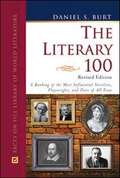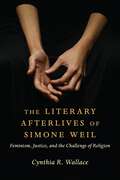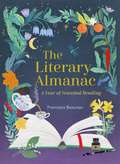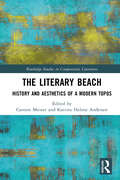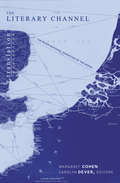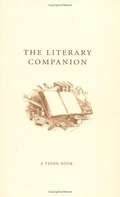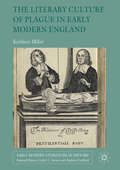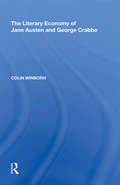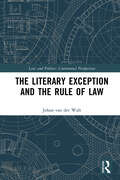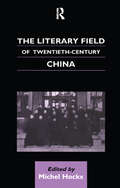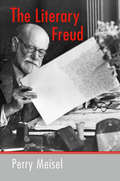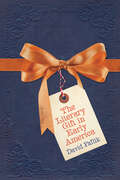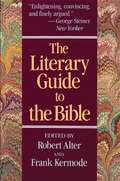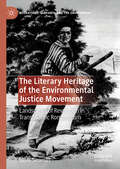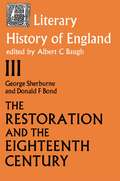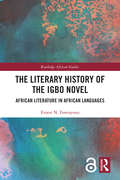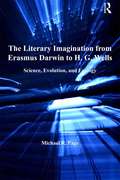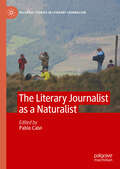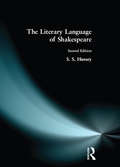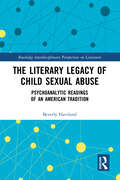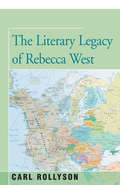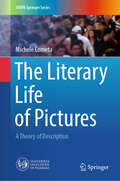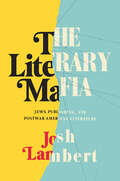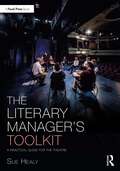- Table View
- List View
The Literary 100: A Ranking of the Most Influential Novelists, Playwrights, and Poets of All Time
by Daniel S. BurtBurt (literature, Wesleyan University) updates his 2001 edition of the one hundred most influential writers of all time, adding twenty-five to the list. To decide on whom to include, Burt polled both other scholars and students. In the end, he also relied on his own judgment. While most of the writers are from the Western tradition, he also includes African, Chinese and Japanese works, all of which are available in English translations. The entries are arranged idiosyncratically. Each one contains a portrait (if possible) and begins with a quotation either from or about the author. Burt gives a thumbnail sketch of the person's life and work, along with the reason why he or she was selected. Annotation ©2009 Book News, Inc., Portland, OR (booknews.com)
The Literary Afterlives of Simone Weil: Feminism, Justice, and the Challenge of Religion (Gender, Theory, and Religion)
by Cynthia R. WallaceThe French philosopher-mystic-activist Simone Weil (1909–1943) has drawn both passionate admiration and scornful dismissal since her early death and the posthumous publication of her writings. She has also provoked an extraordinary range of literary writing focused on not only her ideas but also her person: novels, nonfiction, and especially poetry. Given the challenges of Weil’s ethic of self-emptying attention, what accounts for her appeal, especially among women writers?This book tells the story of some of Weil’s most dedicated—and at points surprising—literary conversation partners, exploring why writers with varied political and religious commitments have found her thought and life so resonant. Cynthia R. Wallace considers authors who have devoted decades of attention to Weil, such as Adrienne Rich, Annie Dillard, and Mary Gordon, and who have written poetic sequences or book-length verse biographies of Weil, including Maggie Helwig, Stephanie Strickland, Kate Daniels, Sarah Klassen, Anne Carson, and Lorri Neilsen Glenn. She illuminates how writing to, of, and in the tradition of Weil has helped these writers grapple with the linked harms and possibilities of religious belief, self-giving attention, and the kind of moral seriousness required by the ethical and political crises of late modernity. The first book to trace Weil’s influence on Anglophone literature, The Literary Afterlives of Simone Weil provides new ways to understand Weil’s legacy and why her provocative wisdom continues to challenge and inspire writers and readers.
The Literary Almanac: A year of seasonal reading
by Francesca BeaumanDiscover over 300 seasonal book recommendations in the ultimate reading list for book lovers everywhere.-----'I will be giving this book to everyone I know' - Elizabeth Day'Francesca Beauman writes about the books she loves with irresistible passion, knowledge and warmth ... This is the best kind of reading celebration' - Rachel Joyce-----Spanning the dreary, cold days of January to the first flushes of spring and then the blazing August heat, bibliophile Francesca Beauman offers up a wealth of book recommendations. From The Count of Monte Cristo to Elena Ferrante's Neapolitan Quartet, each has been selected to chime with a particular time of year and provide a richer reading experience. Beautifully illustrated throughout, this charming guide will delight, inspire and seriously extend your 'To Be Read' list!
The Literary Beach: History and Aesthetics of a Modern Topos (Routledge Studies in Comparative Literature)
by Carsten Meiner Katrine Helene AndersenAs a geo-historical place, the beach integrates a variety of characteristics and functions so multiple that they tend to contradict each other. The beach is both a place of work and trade but also of leisure; it is both a place of therapy and health but also of migration, war, and death; it is a place of mass tourism and boredom but also the place of experiencing the Other; it is a public place but also an uncivilized and desolate place.This book studies the literary representation of the beach from ancient Greek literature up until today, drawing on English, French, Italian, American, and Spanish literatures from various periods and genres and presenting multiple ways of comparing and understanding literary beaches as a ubiquitous literary phenomenon. It demonstrates how the literary beach as a both geo-historical place and as an aesthetic literary commonplace has been a constant and privileged resource for the analysis of more general existential, sociological, and moral problems. This is the case when for instance the Tahitian beach becomes the place of the "already modern" in Stevenson's tales, or when the Italian beach becomes a question of modern feminism in Ferrante.In this sense, literature expands the local or national beach by articulating its transnational complexities.
The Literary Channel: The Inter-National Invention of the Novel
by Carolyn Dever Margaret CohenThe Literary Channel defines a crucial transnational literary "zone" that shaped the development of the modern novel. During the first two centuries of the genre's history, Britain and France were locked in political, economic, and military struggle. The period also saw British and French writers, critics, and readers enthusiastically exchanging works, codes, and theories of the novel. Building on both nationally based literary history and comparatist work on poetics, this book rethinks the genre's evolution as marking the power and limits of modern cultural nationalism. In the Channel zone, the novel developed through interactions among texts, readers, writers, and translators that inextricably linked national literary cultures. It served as a forum to promote and critique nationalist clichés, whether from the standpoint of Enlightenment cosmopolitanism, the insurgent nationalism of colonized spaces, or the non-nationalized culture of consumption. In the process, the Channel zone promoted codes that became the genre's hallmarks, including the sentimental poetics that would shape fiction through the nineteenth century. Uniting leading critics who bridge literary history and theory, The Literary Channel will appeal to all readers attentive to the future of literary studies, as well as those interested in the novel's development, British and French cultural history, and extra-national patterns of cultural exchange. Contributors include April Alliston, Emily Apter, Margaret Cohen, Joan DeJean, Carolyn Dever, Lynn Festa, Françoise Lionnet, Deidre Shauna Lynch, Sharon Marcus, Richard Maxwell, and Mary Helen McMurran.
The Literary Companion
by Emma JonesWithin these pages are hundreds of facts and stories about reading and writing, from the earliest printed books to today's bestsellers.
The Literary Culture of Plague in Early Modern England
by Kathleen MillerThis book is about the literary culture that emerged during and in the aftermath of the Great Plague of London (1665). Textual transmission impacted upon and simultaneously was impacted by the events of the plague. This book examines the role of print and manuscript cultures on representations of the disease through micro-histories and case studies of writing from that time, interpreting the place of these media and the construction of authorship during the outbreak. The macabre history of plague in early modern England largely ended with the Great Plague of London, and the miscellany of plague writings that responded to the epidemic forms the subject of this book.
The Literary Economy of Jane Austen and George Crabbe (The\nineteenth Century Ser.)
by Colin WinbornThough Jane Austen (1775-1817) and the poet George Crabbe (1754-1832) each wrote during the Napoleonic Wars, no full-length study has considered the importance of these pivotal events to their writing. In The Literary Economy of Jane Austen and George Crabbe, the author argues that both writers were unusually responsive to the economic anxieties specific to wartime, occasioned especially by the Napoleonic trade embargo imposed on Britain from 1806 to 1812, and shared a particular concern with the economizing of space. The author's term 'spatial economy' refers to the practice of turning available resources to the best possible account, which these authors applied even to the practice of writing as they strove to preserve space on the page (Austen in her letters and Crabbe in the couplet). Their work displays a preoccupation with boundaries, pressure, and containment, which also informs economic treatises published during this period. Through close readings and fresh contextual and historical analysis that draws on the ideas of contemporary thinkers such as Thomas Malthus, William Spence, William Cobbett, Arthur Young, and Humphrey Repton, Winborn not only establishes a close affinity between Austen and Crabbe but makes a convincing case for rethinking the relationship between the novel and poetry during the Romantic period.
The Literary Exception and the Rule of Law (Law and Politics)
by Johan Van Der WaltAddressing the influential analysis of law and literature, this book offers a new perspective on their relationship. The law and literature movement that has gained global prominence in the course of last decades of the twentieth and the first decades of the twenty-first centuries has provided the research and teaching of law with a considerable body of new and valuable knowledge and understanding. Most of the knowledge and insights generated by the movement concern either a thematic overlap between legal and literary discourses – suggesting they deal with the same moral concerns – or a rhetorical, semiotic or general linguistic comparability or ‘sameness’ between them – imputing to both the same or very similar narrative structures. The Literary Exception and the Rule of Law recognises the wealth of knowledge generated by this approach to the relationship between law and literature, and acknowledges its debt to this genre of scholarship. It nevertheless also proposes, on the basis of a number of revealing phenomenological inquiries, a different approach to law and literary studies: one that emphasises the irreducible difference between law and literature. It does so with the firm believe that a regard for the very different and indeed opposite discursive trajectories of legal and literary language allows for a more profound understanding of the unique and indeed separate roles that the discourses of law and literature generally play in the sustenance of relatively stable legal cultures. This important rethinking of the relationship between law and literature will appeal to scholars and students of legal theory, jurisprudence, philosophy, politics and literary theory.
The Literary Field of Twentieth Century China (Chinese Worlds)
by Michel HockxAt least since the late nineteenth century onwards, Chinese literature as a form of cultural production has been taking place within a specific social space, including writers, critics, journalists, editors, publishers, printers and booksellers. Focusing on people as well as on texts, and looking at what writers did as well as at what they wrote, the essays in this volume draw a vivid and variegated picture of Chinese literary life throughout the modern period. The book treats differences between periods, but also traces the continuities that have characterised modern Chinese literary practice and its discourses from the beginning to the present, including ties of allegiance, utilisation of 'the people' and appropriation of the west. The book places modern Chinese literature firmly within its socio-historical context, thereby increasing the reader's awareness of the hidden assumptions behind literary production. In doing so, it opens new perspectives on Chinese culture as a whole, and on literature as a cosmopolitan concept.
The Literary Freud
by Perry MeiselIn this book, Perry Meisel argues that Freud's texts are properly literary, and casts Freud as both literary theoretician and practitioner. Here, after an introductory reception history of Freud as literature, Meisel provides a series of close readings of Freud's major texts that take literary representation as their central focus. As for Freud's influence on others, it, too, is structured like a literary history, argues Meisel. He discusses Freud's influence on modernism, Strachey's Standard Edition (once again the subject of debate with the recent Penguin retranslations), and Freud's influence on Michel Foucault. Finally, we explore the relationship of Freud and literature. Does an understanding of how Freud himself writes and influences help us to read literature and interpret it anew?
The Literary Gift in Early America
by David FaflikSome of the most meaningful moments in early American literature relied on historical patterns of gift exchange, David Faflik argues in this compelling book. Gift exchange kept a surprising variety of literary objects in circulation across the diverse societies, economies, and cultures of the Americas, from the seventeenth through the nineteenth centuries. From the gifting of a Narragansett grammar as a foundational event in the project of colonization in New England, to the use of Benjamin Franklin's Poor Richard's Almanack in the classrooms of an independent Brazil, to Catharine Maria Sedgwick's fictions framing literature as the object of middle-class gifting, chapters offer an interdisciplinary perspective on book history and literary history in the United States and beyond. Faflik contends that it is because of the wild ways in which books circulated as gifts that works by Franklin, New England colonist Roger Williams, Sedgwick, Walt Whitman, and Emily Dickinson resisted the generic conventions of their day. Offering a revisionist account of how literary meaning is made, The Literary Gift in Early America calls for closer attention to the historical patterns of literary give and take in the Americas.
The Literary Guide to the Bible
by Robert Alter and Frank KermodeRediscover the incomparable literary richness and strength of a book that all of us live with an many of us live by. An international team of renowned scholars, assembled by two leading literary critics, offers a book-by-book guide through the Old and New Testaments as well as general essays on the Bible as a whole, providing an enticing reintroduction to a work that has shaped our language and thought for thousands of years.
The Literary Heritage of the Environmental Justice Movement: Landscapes of Revolution in Transatlantic Romanticism (Literatures, Cultures, and the Environment)
by Lance NewmanThe Literary Heritage of the Environmental Justice Movement showcases environmental literature from writers who fought for women’s rights, native rights, workers’ power, and the abolition of slavery during the Romantic Era. Many Romantic texts take flight from society and enact solitary white male encounters with a feminine nature. However, the symbolic landscapes of Romanticism were often radicalized by writers like Olaudah Equiano, Frederick Douglass, William Apess, George Copway, Mary Wollstonecraft, Lydia Maria Child, John Clare, and Henry Thoreau. These authors showed how the oppression of human beings and the exploitation of nature are the twin driving forces of capitalism and colonialism. In addition to spotlighting new kinds of environmental literature, this book also reinterprets familiar texts by figures like William Blake, Nathaniel Hawthorne, Mary Shelley, William Wordsworth, and Walt Whitman, and it shows how these household figures were writing in conversation with their radical contemporaries.
The Literary History of England: Vol 3: The Restoration and Eighteenth Century (1660-1789)
by George Sherburn and Donald F. BondThe paperback edition, in four volumes, of this standard work will make it readily available to students. The scope of the work makes it valuable as a work of reference, connecting one period with another and placing each author clearly in the setting of his time. Reviewing the first edition, The Times Literary Supplement commented: ‘in inclusiveness and in judgment it has few rivals of its kind’. This third volume covers the Restoration and the Eighteenth Century (1660-1789) and is co-authored by George Sherburn and Donald F. Bond (both at the University of Chicago).
The Literary History of the Igbo Novel: African Literature in African Languages (Routledge African Studies)
by Ernest N. EmenyonuThis book looks at the trends in the development of the Igbo novel from its antecedents in oral performance, through the emergence of the first published novel, Omenuko, in 1933 by Pita Nwana, to the contemporary Igbo novel. Defining "Igbo literature" as literature in Igbo language, and "Igbo novel" as a novel written in Igbo language, the author argues that oral and written literature in African indigenous languages hold an important foundational position in the history of African literature. Focusing on the contributions of Igbo writers to the development of African literature in African languages, the book examines the evolution, themes, and distinctive features of the Igbo novel, the historical circumstances of the rise of the African novel in the pre-colonial, era and their impact on the contemporary Igbo novel. This book will be of interest to scholars of African literature, literary history, and Igbo studies.
The Literary Imagination from Erasmus Darwin to H.G. Wells: Science, Evolution, and Ecology
by Michael R. PageAt the close of the eighteenth century, Erasmus Darwin declared that he would 'enlist the imagination under the banner of science,' beginning, Michael Page argues, a literary narrative on questions of evolution, ecology, and technological progress that would extend from the Romantic through the Victorian periods. Examining the interchange between emerging scientific ideas-specifically evolution and ecology-new technologies, and literature in nineteenth-century Britain, Page shows how British writers from Darwin to H.G. Wells confronted the burgeoning expansion of scientific knowledge that was radically redefining human understanding and experience of the natural world, of human species, and of the self. The wide range of authors covered in Page's ambitious study permits him to explore an impressive array of topics that include the role of the Romantic era in the molding of scientific and cultural perspectives; the engagement of William Wordsworth and Percy Shelley with questions raised by contemporary science; Mary Shelley's conflicted views on the unfolding prospects of modernity; and how Victorian writers like Charles Kingsley, Samuel Butler, and W.H. Hudson responded to the implications of evolutionary theory. Page concludes with the scientific romances of H.G. Wells, to demonstrate how evolutionary fantasies reached the pinnacle of synthesis between evolutionary science and the imagination at the close of the century.
The Literary Journalist as a Naturalist (Palgrave Studies in Literary Journalism)
by Pablo CalviThis book is a scholarly anthology that proposes a deep discussion about the multiple ways in which narrative journalism has portrayed nature, human interactions with nature, the global actions and the consequences of activities that have either attempted to explore it, exploit it, harness it, dominate it, and protect it. This essay collection offers an academic framework for literary journalistic narratives about nature and includes the study of long form journalism originated in different corners of the world, all exploring human-non human-nature interactions in all their power, finitude, peril and urgency.
The Literary Language of Shakespeare
by S.S. HusseyProfessor Hussey looks at the vocabulary, syntax and register of Renaissance English, following this with a more detailed analysis of particular kinds of language in the plays such as prose, verse, rhetoric and the soliloquy. For this new edition, the text has been revised throughout with, in particular, a completely new chapter providing detailed readings of selected plays, illustrating the ways particular aspects of language can be studied in practice.
The Literary Legacy of Child Sexual Abuse: Psychoanalytic Readings of an American Tradition (Routledge Interdisciplinary Perspectives on Literature)
by Beverly HavilandThis book examines the representation of child sexual abuse in five American novels written from 1850 to the present. The historical range of the novels shows that child sexual abuse is not a new problem, although it has been called by other names in other eras. The introduction explains what literature and literary criticism bring to persistent questions that arise when children are sexually abused. Psychoanalytic concepts developed by Freud, Ferenczi, Kohut, and Lacan inform readings of the novels. Theories of trauma, shame, psychosis, and perversion provide insights into the characters represented in the stories. Each chapter is guided by a difficult question that has arisen from real-life situations of child sexual abuse. Legal and therapeutic interventions respond with their disciplinary resources to these questions as they concern victims, perpetrators, and witnesses. Literary criticism offers another analytic framework that can significantly inform those responses.
The Literary Legacy of Rebecca West
by Carl RollysonThe Literary Legacy of Rebecca West is the first book to explore the entire corpus of her extraordinary seventy-one year writing career. The general introductory studies of West are outdated and do not take into account her posthumous publications, or her large literary archive of unpublished letters and manuscripts. Previous scholarly books have chopped West up into categories and genres instead of following the evolution of her career.
The Literary Legacy of the Macmillan Company of Canada
by Ruth PanofskyFifth Business and Alligator Pie. Stephen Leacock, Grey Owl, and Morley Callaghan: these treasured Canadian books and authors were all nurtured by the Macmillan Company of Canada, one of the country's foremost twentieth-century publishing houses. The Literary Legacy of the Macmillan Company of Canada is a unique look at the contribution of publishers and editors to the formation of the Canadian literary canon.Ruth Panofsky's study begins in 1905 with the establishment of Macmillan Canada as a branch plant to the company's London office. While concentrating on the firm's original trade publishing, which had considerable cultural influence, Panofsky underscores the fundamental importance of educational titles to Macmillan's financial profile. The Literary Legacy of the Macmillan Company of Canada also illuminates the key individuals - including Hugh Eayrs, John Gray, and Hugh Kane - whose personalities were as fascinating as those of the authors they published, and whose achievements helped to advance modern literature in Canada.
The Literary Life of Pictures: A Theory of Description (UNIPA Springer Series)
by Michele CometaThis book offers a theory of ekphrasis—the literary description of an artwork—from the perspective of Visual Culture studies. A theory of ekphrasis must take into account not only the rhetorical strategies articulated in the description of artworks, but also the complex interplay that holds together the pictures that are described, the gazes that rest on them, and the dispositives that mediate them. It is therefore a matter of linking the study of the verbal rhetoric with the dynamics that are established between the author, the reader, and the visual artworks, real or fictive, as well as the performative aspects of description and the mediascapes that, from time to time, condition the gaze and the visual experience of the authors and the readers. This book proposes thus to consider both the intradiegetic aspects of description and the extradiegetic ones that condition its verbal texture. Following the rhetorics of ekphrasis throughout the Western tradition, from its origins in Philostratus, its reappraisal by Johann Joachim Winckelmann, to the twentieth-century avant-garde, this book shows how ekphrastic techniques are historically determined by the relationship between pictures, gazes, and dispositives.
The Literary Mafia: Jews, Publishing, and Postwar American Literature
by Josh LambertAn investigation into the transformation of publishing in the United States from a field in which Jews were systematically excluded to one in which they became ubiquitous &“Readers with an interest in the industry will find plenty of insights.&”—Publishers Weekly &“From the very first page, this book is funnier and more gripping than a book on publishing has any right to be. Anyone interested in America&’s intellectual or Jewish history must read this, and anyone looking for an engrossing story should.&”—Emily Tamkin, author of Bad Jews In the 1960s and 1970s, complaints about a &“Jewish literary mafia&” were everywhere. Although a conspiracy of Jews colluding to control publishing in the United States never actually existed, such accusations reflected a genuine transformation from an industry notorious for excluding Jews to one in which they arguably had become the most influential figures. Josh Lambert examines the dynamics between Jewish editors and Jewish writers; how Jewish women exposed the misogyny they faced from publishers; and how children of literary parents have struggled with and benefited from their inheritances. Drawing on interviews and tens of thousands of pages of letters and manuscripts, The Literary Mafia offers striking new discoveries about celebrated figures such as Lionel Trilling and Gordon Lish, and neglected fiction by writers including Ivan Gold, Ann Birstein, and Trudy Gertler. In the end, we learn how the success of one minority group has lessons for all who would like to see American literature become more equitable.
The Literary Manager's Toolkit: A Practical Guide for the Theatre (The Focal Press Toolkit Series)
by Sue HealyThe Literary Manager’s Toolkit is a clear and comprehensive guide to the role of the literary manager in theatre and beyond, focusing on the key skills, networks, and processes that underpin a successful career in this and associated roles. This book outlines the tasks and responsibilities of a literary manager in the selection, development, and production of new plays. In the first part, it outlines the how, when, and why of the literary manager’s main activities, equipping the reader with everything that they will need when approaching this role’s central challenges. The second part provides a selection of practical, accessible, and easy-to-follow materials and workshop suggestions for literary managers who will work with playwrights as they develop their creative writing and dramaturgy skills. This is the go-to resource for the working professional literary manager or dramaturg, and for students on dramaturgy courses in theatre degree programmes.
